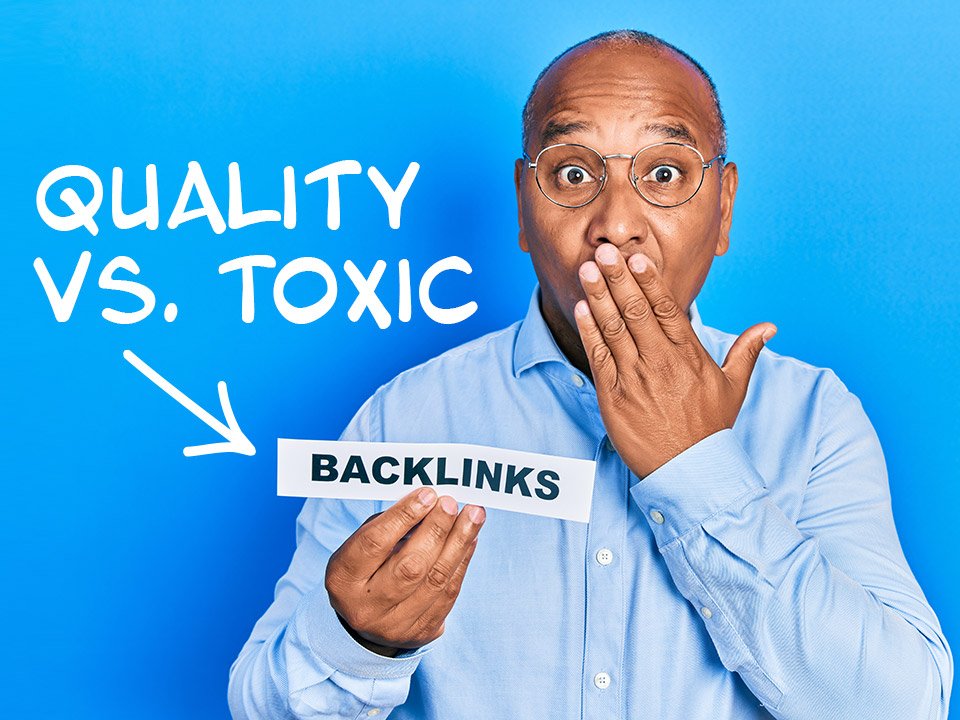
Guide to Identify Quality vs. Toxic Backlinks
There is more to a solid SEO strategy than using the right keywords in the right places. SEO rankings and visibility are influenced by many other things as well, such as backlinks. But what are backlinks? How do they affect ranking and visibility? More importantly, how can you identify toxic backlinks, remove them, and create quality backlinks instead?
What Are Backlinks?
A backlink is merely a link from one site to another. They are also known as ‘inbound links’, ‘incoming links’, ‘external links’, and ‘one way links’. Here’s an example of backlinks work:
Ashley is a college student and a blogger who writes about her experiences living on campus. She writes a post about the things she and other college students are doing to manage their stress and mental health, and how her school is very accommodating to students in need.
Maria is a psychologist as well as a blogger, and her pieces are sometimes featured in well-known publications like Psychology Today. She writes an article about the latest study on college students and mental health. Her piece cites Ashley’s blog and includes a link back to her original blog post. Her blog is reposted as an article which is published in Psychology Today.
The clinic where Maria works has the link to her blog on the ‘Meet Our Team’ page on their website. John, a patient at the clinic, but not a patient of Maria’s, shares the link to the ‘Meet Our Team’ page on his social media account.
Mark writes an op ed criticizing a college in his hometown, and he submits it to the website of the local news station. His op ed cites Maria’s article in Psychology Today.
Anyone who visits Maria’s blog could also see Ashley’s blog. Anyone who visits the republished article in Psychology Today could see Maria’s blog, and then go to Ashley’s blog. Anyone who visits the website of her clinic, such as John’s friends on social media, could see Maria’s article, which then takes them to the original piece on her blog, and from there they can go to Ashley’s blog. Likewise, anyone who reads Mark’s op ed could check out Maria’s article in Psychology Today and then go to her blog, after which they could visit Ashley’s blog post that started it all.
Theoretically, this could continue on and one and on infinitely. Each backlink creates an opportunity for a reader to visit someone else’s work, and thus their website.
Why Are Quality Backlinks Important?
At first glance that might sound simple and harmless, but backlinks have a strong impact on your site’s traffic, visibility, and overall performance. You might be thinking that having as many backlinks to your site as possible would be advantageous, but that’s not entirely true. Quality matters much more than quantity when it comes to backlinking.
This can be difficult for smaller businesses and writers, whose work isn’t likely to be featured in a major publication such as Psychology Today, Forbes, or The Huffington Post. While it’s true that a high number of domains linking back to your site will positively influence your ranking, the more backlinks you have the higher your chances of generating backlinks from spammy or poorly-performing websites. Further, focusing on quantity rather than quality means those links become less valuable as you continue to generate more.
What Can Toxic Backlinks Do?
We’ve established that quality is, in the long run, much better for your site than quantity. Having a large number of backlinks doesn’t equal toxic backlinks though, that only happens when those spammy and poorly-performing websites that were mentioned earlier enter the picture.
Search engines see backlinks as a ‘vote of confidence’, according to Moz. And thanks to Google’s 2012 algorithm update, which targets low-quality links, penalties for toxic backlinks are automatically applied. These penalties reduce your ranking, and having too many means that your site will be removed from the index altogether. Google also has a team dedicated to finding said spammy sites and applying those penalties manually. This team reviews user complaints that are reporting websites for spam or if the algorithm triggers the need for a manual review.
Remember that old saying, you are the company you keep? It adequately sums up the way backlinks can lead to promising growth or cause some serious damage.
Characteristics
More often than not a penalty is given by the algorithm, rather than a person, and that algorithm uses some specific criteria for determining toxic backlinks. They can be found on the following pages.
Toxic
- Mirror pages, such as a domain with multiple links back to your site that use the same anchor text or a page backlinking to you which is hosted on multiple different domains
- Low domain power, the ratio from Trust Score to Domain Score
- Sites that aren’t indexed by Google
- Sites which exist solely for linking out, such as low-quality directories
- Sites which exist solely for cross-linking
- Sites or content which are not relevant to the sites which they are backlinking
- Sites with a poor layout, such as sites with a low visible text to HTML ratio
- Sites with viruses and/or malware
Based on the criteria above it’s easy to see what some of the characteristics of high quality links might be, but here’s a much more comprehensive list of traits.
Quality
- A link to your business’ website on a business review site
- A link to your product on the site of a well-known blogger, such as a product review or recommendation
- A link to your blog as a source in a news article
- A link to your website on social media
- A link to a press release that exists solely to put your name out, but not offer anything of note
Quality links are only half the battle, of course. It’s one thing to bring more people to your site but you need to make sure they have reason to stay as well. A clean, simple, and welcoming landing page that loads quickly is a great start.
Removing Toxic Backlinks
There are numerous online tools which you can use to calculate how many toxic backlinks you have and how greatly that number is affecting your site. Once you have identified those toxic backlinks you have two options.
The first thing you can do, as well as the simplest, is to contact the webmaster of any site that’s providing a toxic backlink and ask them to remove it. You don’t even need to tell them that the backlink is toxic, only that you’re optimizing your SEO strategies and are being extremely selective towards who is allowed to backlink you.
If that doesn’t work you can use Google’s Disavow Tool, which allows you to submit a file featuring all of the toxic backlinks and telling Google to ignore them. Anytime you find new toxic backlinks you will need to submit another report.
Creating Quality Backlinks
So how can you make sure the backlinks generated are going to boost your ranking? The first thing you can do is partner up with a results based growth marketing company to work on a strong SEO strategy together. They’ll likely advise you to do some of the following, but having them on your side will make it easier to accomplish and they will ensure your backlinks are optimized.
- Guest blogging for another website. Include the link to your own site in the author profile you create.
- Creating a press release when you have something worth sharing, such as announcing a new product.
- Create high quality content such as blog posts.
- Create content which can be shared on social media sites such as quizzes, video content, and ebooks.
- Create a LinkedIn profile to not only establish your website as credible, but yourself as a respectable business owner and authority figure in your field.
- Comment on relevant blog or social media posts so pre-qualified leads can see the link to your site.
- Publish original content using your own business data and surveys which you have conducted.
- Connect with websites which have featured content from your competitors, and offer your own content. Not only does this provide a quality backlink, it also evens the playing field between you and your competitors.
- Connect with popular bloggers or influencers on social media or and have them do a review of your product or a tutorial for using it.
- Write reviews and testimonials on other websites which link back to your own.
- Make it easier for others to share your content by providing HTML which they can copy.
- Create content which has complementary visuals which make it easier or more enjoyable to read.
- Give interviews, either by receiving an invitation or reaching out and giving a pitch for why you should be featured as an authority figure in your industry.
As you’ve probably noticed, creating quality backlinks requires a little creativity on your part. The upside to this is that it’s not nearly as dull as it might sound. It also opens up many opportunities for networking, shows you where your website could use some improvement, and creates a better user experience for anyone who visits your site. Remember that people are more inclined to click on results from the first SERP not because of their popularity, but because they are assumed to be credible and trustworthy. If your site is on the first SERP people will want to check out your content because they know you’ve earned that top spot.


